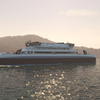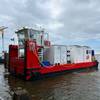The only logical reason the sustained high price per barrel of oil has not already been dubbed "OIL BOOM 2000" is the fact that hindsight is 20/20. Companies that operate, build and supply vessels for the fickle oil patch have seen schizophrenic markets of days past bring industry goliaths to their knees. There remains a reserve among Gulf of Mexico area companies regarding prospects 2000 and beyond, but there is a growing feeling the business - which has largely been dismal since the end of 1997 - is set to embark on one of those notorious end runs that will fill area yards with healthy backlogs for years.
The reason for the "look before you leap" attitude is also largely rooted in changing business dynamics which have effectively altered the way in which the world does business. The current bull-run for oil pricing was largely driven by a decision by OPEC producing countries to curtail production output, at least until March 2000. Fear surrounding the implications of this artificial supply and demand control is real, as speculation runs rampant regarding the direction of the market when and if the production cuts are eliminated.
Also, the torrid pace of corporate consolidation, particularly among the big oil companies, has left an unclear impression as to the direction and heft of Exploration & Production (E&P) budgets. As oil majors fervently attempt to control costs, it is apparent traditional E&P spending will never be the same.
Finally, while the continued recovery of Asian economies is driving the oil products future usage needle up, many of these economies remain shaky at best, and fear of a relapse is present.
Cutting through the ample smoke which political and corporate turmoil often brings, however, it is clear that offshore production technologies - particularly surrounding the ability to find and recover resources in deeper water more cost efficiently - will continue to drive business in the maritime market for years to come.
Deepwater production capabilities, and all of the surrounding vessel, equipment and service technologies which make the process a possibility, will only grow in importance in the decades to come, and GOM area companies are in prime position to both drive and benefit from the trend.
The business trends of consolidation and globalization that have largely defined the late 1990s have touched every level of business in the U.S., including the Gulf of Mexico maritime industry. Companies that had largely depended on "business as usual" are generally out of business today. The result: a resilient industrial base poised to prosper in good times and bad.
"Business is bad right now, as the oilfield is our primary source of business," said Ralston P. Cole, vice-president Gulf Coast Region, Stewart & Stevenson. Cole - who's marine industry career now spans more than three decades and countless market mood swings - noted the company has diversified its business, including selling engines and equipment to new emerging markets such as Paraguay and Argentina, but ultimately, the company's good years will coincide with the health of local boat, ship and rig builders.
While he notes South American business is currently only about 10 percent, it is significant because it is out of sync with the flow of the offshore rig market.Despite newfound efficiencies and markets, as Cole notes, the region is still largely ruled by the price per barrel of oil.
While the nearly two-year oil price swoon has been reversed for much of 1999, rising from around $10 per barrel in March to nearly $25 per barrel in September, the general mood of area businesses is still cautious, as confidence is generally based on firm orders in hand rather than slick market projections. This caution has proven to be prudent.
Technological Advances
Impressions of the Gulf of Mexico vessel building businesses range from "mom 'n' pop shop" to efficient, technically advanced shops. While there are still plenty of the former, the more accurate description today would have to be the latter, as there has been a significant amount of investment in the physical facilities and processes needed to build vessels of all sizes and configurations competitively on the international market.
Litton Ship Systems is the largest and perhaps best-recognized ship builder in the area, if for no other reason than the high recognition of its diverse defense-orientated parent, Litton. The company now includes both Avondale Industries and Ingalls Shipbuilding under the company banner, and is poised under the leadership of Jerry St. Pé.
The company's navy newbuilding reputation is without equal, and Litton, with the recent acquisition of Avondale Industries, has expanded its capabilities significantly to aid its future naval and commercial prospects.
In New Orleans, the first of the technically advanced Millennium class tankers is nearing completion for ARCO. The ships, which offer redundant systems throughout, are considered to be one of the more technologically advanced tanker projects in the world.
Ingalls Shipbuilding was able to make significant in-roads during the last offshore vessel and rig building boom, and is well positioned to weather the market downturn while being prepared for the fast ramp up. Its work in this area included eight months of outfitting and final prep work on 100,000 ton Discoverer Enterprise. Work included lifting the 2,250 ton substructure drill floor onto the drilling ship, and conducting test and trial to ensure the ship was "drill ready" for Amoco.
According to Mike Williams, director of Ingalls' Offshore Programs Business Development, Ingalls is well positioned to handle not only the technical demands but also the various cycles of the offshore market. Since most of Ingalls revenue is generated on the naval vessel side, the shipyard has an enviable continuity of workforce and technical expertise. Also, the company's accessibility to the Gulf - just 11 miles from the deepwater GOM with no air draft restrictions - gives the yard the capability to handle the largest projects.
Steady Expansion
Bollinger Shipyard, in Lockport, La., has been steadily expanding and increasing its capabilities, seemingly making giant strides forward in non-ideal business conditions. The company has just finished implementing an advanced software solution system, which effectively has tied all divisions together in an information sharing arrangement that will create new levels of efficiency and quality management.
The company is unique in that it runs a healthy share of commercial and military business through its facilities, as Scott Theriot, executive vice-president of new construction, estimates 35 percent of the company's newbuilding business is military related. (Overall, the company has a fairly even 50/50 repair/new construction split.) Still, he admits the process of becoming a good military and commercial yard entails a lot of trial and error, Theriot said.
A significant military contract has been for the construction of the Cyclone class patrol coastal ship. Bollinger recently launched USS Tornado. While it was the 14th of the Cyclone Class built by Bollinger, under a sole-source contract with the Navy, the vessel is the first to include design modifications, equipment and armament upgrades as part of the Navy's Pre-Planned Product Improvement Program.
Boasting a new, fully integrated bridge command and control system to increase the vessel's capabilities, Tornado is equipped with a satellite navigation system, forward looking infrared and surface radar with collision avoidance capabilities.The vessel is based on the Vosper Thornycroft Ramadan class design and modified to meet Navy requirements. One specific change is the extension of the stern, which includes a ramp for the launch and recovery, while underway, of naval special warfare boats. As a result of this process, Tornado increased in length to 179 ft. from the 170 ft. earlier models.
As a further validation of its prowess on the military side of the business, Bollinger announced the receipt of a $5.1 million contract to modify three Patrol Coast Ships (PC) for the U.S. Navy. The company has an option on a fourth vessel, which are of the Cyclone Class, which would bring the contract value to more than $6.7 million.
On the commercial side, Bollinger is nearly complete with a unique project in the building of 105-ft. Vera Bisso, for E.N. Bisso & Son, Inc. The vessel (featured in the October 4, 1999 edition of MarineNews), is built for dual applications, as it can serve as a ship assist vessel along the Mississippi river, but is also capable of performing offshore work.
Horizon Shipbuilding in Bayou La Batre, Ala. and Travis E. Short, its president and CEO, have roots in the GOM maritime market dating back to Hudson Shipbuilding, which operated up until the first oil bust in the early 1980s, and Owen Short Marine, which split apart two years ago. Horizon Shipbuilding recently signed a contract for the construction of a 135 x 32 ft. dinner cruise vessel for an unnamed client.
Scheduled for a March 2000 delivery, construction of the vessel commenced at Horizon's Bayou LaBatre, Ala. facility. Designed by A.K. Suda Naval Architects and Marine Engineers, the vessel will be certified to USCG Subchapter K regulations for vessels under 100-gt.
Twin Caterpillar 3408 diesel marine turbocharged engines will power the vessel with electrical power provided by two 105 kW and one 170 kW CAT powered generators. The company was also recently awarded a contract to construct a series of 30 ft. fiberglass Improved Surface Tow Targets (ISTT) for the U.S. Naval Air Warfare Center, Weapons Division in Point Mugu, Calif.
According to Short, the total contract calls for the delivery of more than 30 units throughout the next two years.
Sweet Home Alabama
Whereas Ingalls gets the majority of its business from the government, Atlantic Marine Holding Co.'s two yards in Mobile - Alabama Shipyard (new construction) and Atlantic Marine-Mobile (repair and conversion - are wholly dependent on the commercial market for their success. E.C. "Buddy" McCormick, president of Atlantic Marine-Mobile, attributes this commercial-only vision as a major plank in ensuring his customer's satisfaction, as it allows the ship repair and conversion professionals maximum flexibility in deploying the company's vast resources.
"Our customers don't like to come into a shipyard," he says. "They'd rather their ships be operating and making money. So our focus is on turnaround time...we get them in and get them out."
While he admits it might have been easy to be seduced by government work in the face of recent down offshore and marine markets, he staunchly believes - in part from traveling the globe and visiting repair and conversion colleagues - that government and commercial work don't mix.
McCormick says Atlantic Marine-Mobile is a take-charge shipyard, and while the company is not always the low bidder, it always provides the best value.The company's president lists people, facilities and culture as the top reasons Atlantic Marine-Mobile has enjoyed great success since taking over the old World War II facility in 1989, and his assessment is more accurate than trite upon visiting the facilities.
Alabama Shipyard, the newbuild facility of Atlantic Marine Holding in Mobile, is currently involved in building the first of what it hopes is many OPA '90-compliant ATB barges. The unit -designed by the shipyard in a variety of sizes for a variety of purposes - is a 460 ft., 135,000 barrel capacity notched barge for Reinauer Transportation, scheduled to enter service in December 1999.
The unit will mate with a new 124-ft. tug, Nicole Leigh Reinauer, which is being built at the Atlantic Marine Jacksonville facility.
Karl Senner: Driving the Market
While Michael Senner has had a front row seat to the destruction and turmoil the fickle price of oil lays upon his Gulf of Mexico colleagues and competitors, Karl Senner Inc. - the company his father started more than a quarter of a decade ago - has maintained a steady presence and course.
It is this reliability that helps to attract and maintain customers, he reasons. Unlike diversified companies, which fall back to stronger markets when the marine market turns towards one of its notorious bad spells, Karl Senner Inc. "has all its eggs in one basket…we don't come and go with market swings."
This reliability, instilled as a guiding principle when his father started the company in 1972, has helped the company navigate particularly bad stretches, such as the oil patch bust in the early to 1980s, a time when the company saw its revenue dive from $12 million in 1982 to less than $2 million in 1984.
Karl Senner, Inc. is a fixture in the Gulf of Mexico region for sure, yet it spans the country, with offices on the West Coast and on the East Coast. The company sells and services some of the industry's top-line propulsion systems, including Reintjes marine gearboxes, Rexroth marine controls; Berg Propulsion (CP propellers and bowthrusters) and ABB turbocharger services.
Senner reports business has been "exceptionally good" over the past few years, and with the resurging oil price he's cautiously optimistic for 2000 and beyond. He notes the company's growing service and supply capabilities, which currently accounts for about 10 to 15 percent of revenues - provides a nice fallback for when new construction business falls off.
Senner believes the proliferation of deepwater offshore developments will continue to change the way in which companies like his operate. "The average value of each contract is getting larger, as the sizes of crews, supplies and AHTS' continue to get bigger."
Haley Marine Gear: Building Foundation for Future Success
Haley Marine Gear is another shining example of a Gulf of Mexico company, which was started and is currently a family-run operation. But while Haley has prospered in the business of selling high quality propulsion products for installation on workboats in the 1,000 to 6,000 hp range for nearly 27 years, it is hardly justified to call the operation simply a GOM player, as it has operations and customers around the globe.
While the company was "built one day, one piece at a time" and founded largely on mechanical and engineering expertise, Kyle Haley accurately points out "we're not just a bunch of wrench turners…we are original equipment manufacturers."
Haley Marine Gear has positioned itself as a one-stop-shop, manufacturing clutches, couplings and gears to create a unified power package. Ray Haley, who founded the business and comes from a diesel engine business background, sought to build a company, which not only built and delivered the highest quality products, but built long-term relationships with its customers by servicing these products with the same quality and attention.
The attitude is clearly evident in the first question asked of potential new employees to gauge their technical aptitude. "I ask 'can you tear down a Detroit Diesel engine and rebuild it back up so that it will run?' If they can, I'll send them out in two years by themselves on a job," Haley said.
The company, which includes Haley Marine Gear, Haley Clutch & Co. and Haley Marine Gears Intl., has operations around the world. This global positioning is evident in the company's recent agreement with ATA Gears of Finland - a large supplier of parts for Z-drives - which will position Haley to service the burgeoning number of boats with this propulsion system.
The Haley hallmark, of course, is being selected for inclusion on technically challenging jobs, as it was on current newbuild Vera Bisso, under construction at Bollinger. Vera Bisso features the "total Haley concept," in that it includes Hatch & Kirk engines with the Haley-make flywheels, the Haley HRC Torsional Coupling; the Haley TR Clutch; the Haley FMC Series gearbox; and a Haley shaft.
Subscribe for
Maritime Reporter E-News
Maritime Reporter E-News is the maritime industry's largest circulation and most authoritative ENews Service, delivered to your Email five times per week










